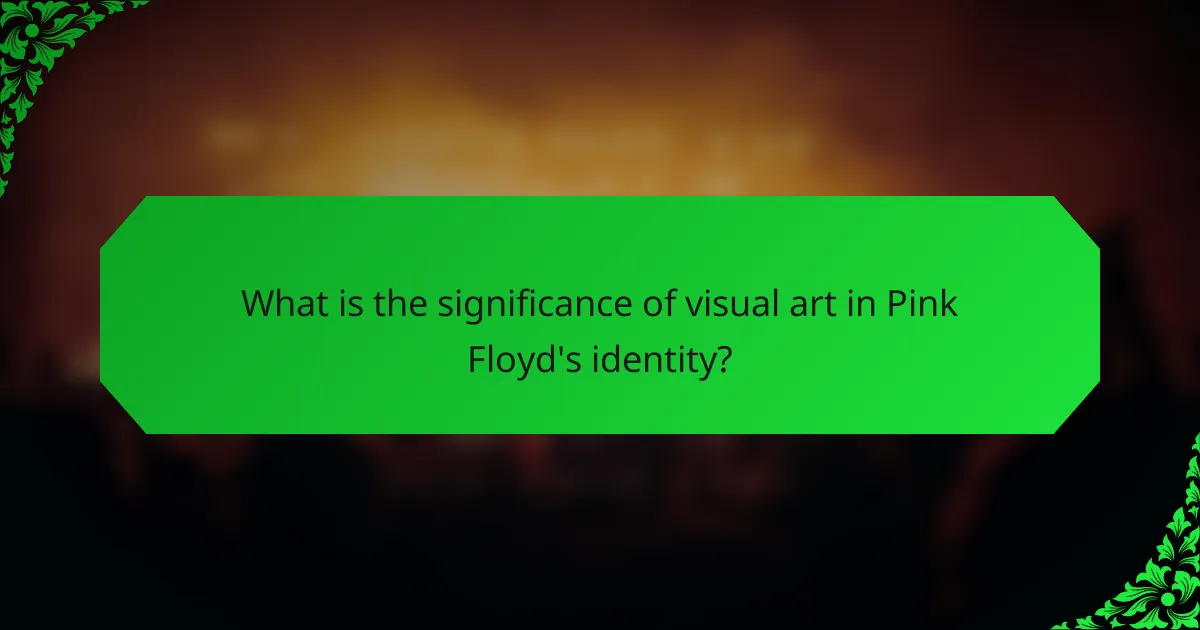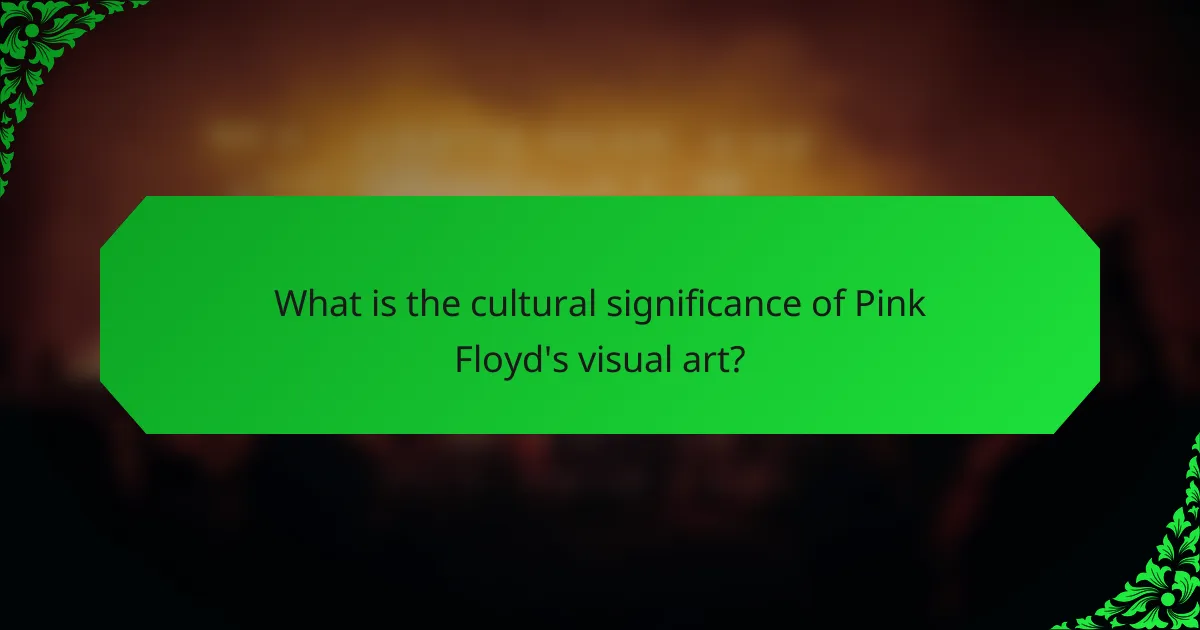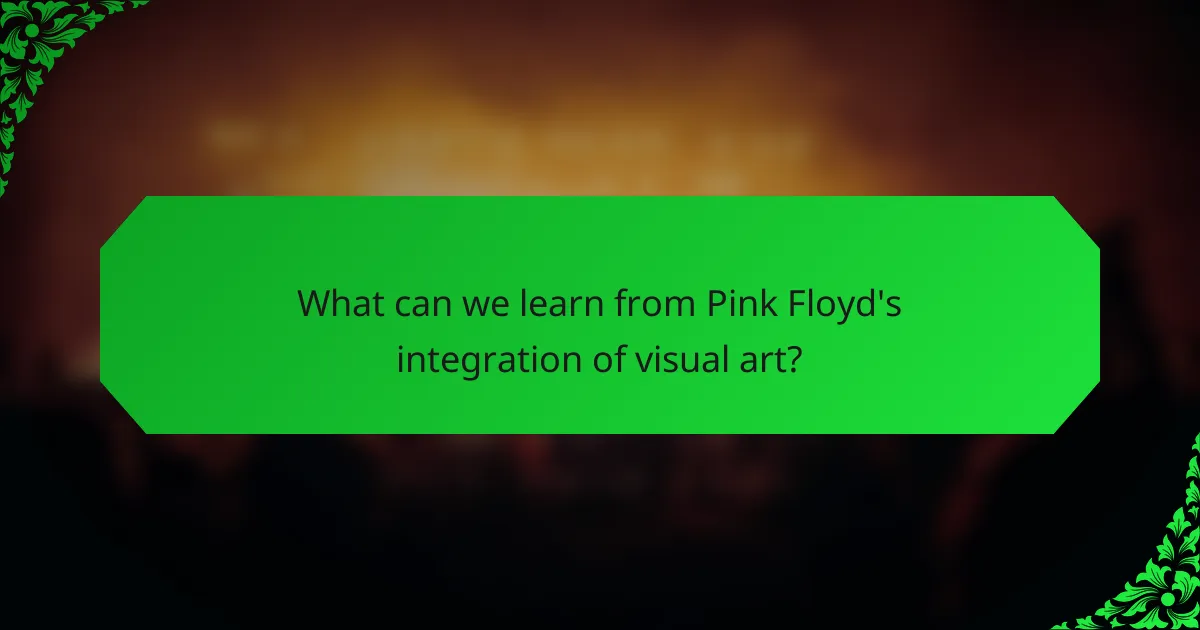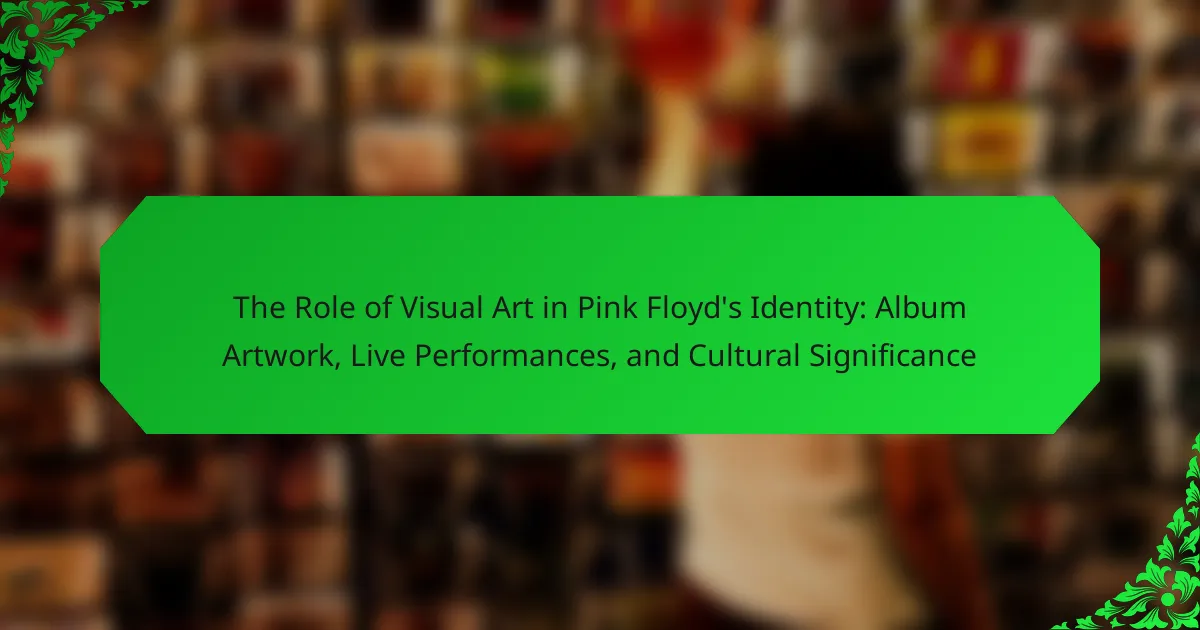The article explores the significant role of visual art in defining Pink Floyd’s identity, focusing on their album artwork, live performances, and cultural impact. It highlights how the band’s album covers, particularly “The Dark Side of the Moon,” visually represent complex themes such as mental health and societal critique, designed by Storm Thorgerson. The integration of elaborate visuals in live performances enhances the audience’s emotional experience, creating a multi-sensory connection. Additionally, the article discusses how Pink Floyd’s visual legacy has influenced popular culture and set a precedent for the fusion of music and art in contemporary artistic expression.

What is the significance of visual art in Pink Floyd’s identity?
Visual art is crucial to Pink Floyd’s identity. It enhances their music through thematic and emotional resonance. The band’s album covers, designed by Storm Thorgerson, convey complex concepts visually. For instance, “The Dark Side of the Moon” features a prism symbolizing the spectrum of human experience. Their live performances incorporate elaborate visuals, including light shows and projections. This integration creates a multi-sensory experience for audiences. The use of visual art has also influenced popular culture, making their imagery iconic. Overall, visual art is a defining element of Pink Floyd’s artistic expression.
How has visual art shaped the band’s overall image?
Visual art has significantly shaped Pink Floyd’s overall image through iconic album covers and immersive live performances. The band’s album artwork, particularly designs by Storm Thorgerson and Hipgnosis, created a distinct visual identity. For example, the cover of “The Dark Side of the Moon” features a prism and has become emblematic of the band. This visual representation aligns with the themes of their music, enhancing emotional impact. Additionally, their live performances incorporated elaborate visuals, such as projected animations and light shows. These artistic elements transformed concerts into multi-sensory experiences. The combination of music and visual art solidified Pink Floyd’s reputation as pioneers in both fields. Overall, visual art has been integral to the band’s cultural significance and enduring legacy.
What are the key visual elements associated with Pink Floyd?
The key visual elements associated with Pink Floyd include prism imagery, surreal landscapes, and abstract designs. The prism symbolizes the band’s exploration of light and sound, prominently featured on the “The Dark Side of the Moon” album cover. Surreal landscapes often reflect themes of alienation and existentialism, as seen in “Wish You Were Here.” Abstract designs, particularly in their live shows, utilize innovative light displays and visual effects. These elements contribute to the band’s identity and enhance the auditory experience. Pink Floyd’s visual art is integral to their cultural significance, influencing both music and visual arts.
How do these elements reflect the band’s musical themes?
The elements of visual art in Pink Floyd’s identity reflect the band’s musical themes by enhancing emotional depth. The album artwork often symbolizes complex concepts such as alienation and existentialism. For instance, the prism on “The Dark Side of the Moon” represents the spectrum of human experience. Live performances incorporate elaborate visuals that create an immersive atmosphere, aligning with the band’s progressive sound. The use of surreal imagery complements lyrical themes of introspection and societal critique. Furthermore, the visual elements often serve as a narrative device, deepening the listener’s connection to the music. This synergy between visual art and sound is crucial in conveying Pink Floyd’s artistic vision.
What role does album artwork play in Pink Floyd’s identity?
Album artwork is integral to Pink Floyd’s identity. It visually represents the themes and concepts explored in their music. For example, the cover of “The Dark Side of the Moon” features a prism, symbolizing the spectrum of light and the complexity of human experience. This album cover has become iconic, representing not just the band but also the broader cultural movements of the 1970s. Additionally, artwork for albums like “The Wall” reflects the narrative and emotional depth of the music. The use of surreal and abstract imagery enhances the listener’s experience and connection to the band’s themes. Pink Floyd collaborated with notable artists like Storm Thorgerson, solidifying their visual identity. Overall, album artwork serves as a crucial element of Pink Floyd’s artistic expression and cultural impact.
What are some iconic album covers created for Pink Floyd?
Some iconic album covers created for Pink Floyd include “The Dark Side of the Moon,” “Wish You Were Here,” and “The Wall.” “The Dark Side of the Moon” features a prism dispersing light, symbolizing the band’s exploration of complex themes. This cover was designed by Storm Thorgerson and has become one of the most recognizable images in music history. “Wish You Were Here” showcases a photograph of two men shaking hands, one of whom is on fire, representing themes of absence and disconnection. “The Wall” features a stark white brick wall, reflecting the album’s narrative of isolation and personal struggle. Each cover is a significant visual representation of the band’s artistic identity and thematic depth.
How do these album covers contribute to the band’s narrative?
Album covers contribute significantly to Pink Floyd’s narrative by visually representing their themes and concepts. Each cover encapsulates the band’s exploration of complex subjects such as alienation, war, and existentialism. For instance, “The Dark Side of the Moon” cover symbolizes the conflict between humanity and the pressures of modern life. The prism design reflects light and the spectrum, representing the band’s innovative sound and philosophical depth. Additionally, “The Wall” cover illustrates the idea of isolation through its stark imagery of a crumbling wall. These visuals align with the music’s emotional landscape, enhancing the listener’s experience. The artwork often provokes thought and discussion, reinforcing the band’s identity as pioneers in both music and visual art.
How does visual art enhance Pink Floyd’s live performances?
Visual art enhances Pink Floyd’s live performances by creating an immersive experience. The band’s shows are renowned for their elaborate visual elements, including light displays and projections. These visuals complement the music, adding emotional depth and context to the performance. For instance, the use of surreal imagery during songs like “Comfortably Numb” intensifies the audience’s emotional response. Additionally, the integration of large-scale animations and thematic visuals helps convey the band’s complex narratives. This artistic approach has set a standard in live music, influencing numerous artists and genres. Overall, visual art is essential in transforming Pink Floyd’s concerts into multi-sensory experiences.
What types of visual art are incorporated into their concerts?
Pink Floyd incorporates various types of visual art into their concerts. These include elaborate light shows, projections, and stage designs. The band’s performances often feature surreal imagery and animations. They utilize large-scale visual displays to enhance the musical experience. The use of puppetry and theatrical elements is also common. Iconic visuals from album covers are frequently integrated into the shows. Additionally, they employ innovative technology for real-time visual effects. These artistic elements contribute significantly to the overall impact of their live performances.
How does the visual presentation affect audience experience?
Visual presentation significantly enhances audience experience by creating emotional and cognitive engagement. Effective visuals can evoke strong emotions, making the content more memorable. Research indicates that visuals increase information retention by up to 65% compared to text alone. In the context of Pink Floyd, their album artwork and live performances utilize striking visuals to deepen the audience’s connection to the music. For instance, the iconic cover of “The Dark Side of the Moon” visually represents complex themes, enhancing listeners’ understanding. Additionally, immersive visual elements during live shows create a multisensory experience, fostering a sense of community among fans. This combination of emotional impact and cognitive reinforcement demonstrates how visual presentation is crucial in shaping audience experience.

What is the cultural significance of Pink Floyd’s visual art?
Pink Floyd’s visual art holds significant cultural importance as it enhances the band’s thematic expression and audience experience. The band’s album covers, particularly “The Dark Side of the Moon,” became iconic symbols of the 1970s counterculture. These visuals often reflect complex themes such as mental health, existentialism, and societal critique. Collaborations with artists like Storm Thorgerson of Hipgnosis created a unique visual identity that complements their music. The use of elaborate stage designs during live performances further deepened the connection between the audience and the music. This integration of visual art and music has influenced countless artists and designers. Pink Floyd’s visual legacy continues to resonate, symbolizing the fusion of art and music in popular culture.
How has Pink Floyd’s visual art influenced popular culture?
Pink Floyd’s visual art has significantly influenced popular culture through innovative album covers and striking live performances. The band’s iconic album cover for “The Dark Side of the Moon” features a prism dispersing light. This imagery has become a symbol of rock music and is widely recognized. Their use of elaborate visuals during concerts set a new standard for live performances. The combination of music and visual art created immersive experiences for audiences. Pink Floyd’s visual style has inspired countless artists and designers across various media. Their artwork often addresses themes of alienation and societal issues, resonating with generations. This cultural impact persists in contemporary music and art, showcasing the band’s lasting legacy.
What are some examples of cultural references to Pink Floyd’s visuals?
Cultural references to Pink Floyd’s visuals include their iconic album cover art and live performance imagery. The prism from “The Dark Side of the Moon” is frequently referenced in various media. It symbolizes the spectrum of human experience and has appeared in films and advertisements. The giant inflatable pig from “Animals” has been used in protests and other artistic expressions. Additionally, the animated visuals from “The Wall” have inspired various art installations and performances worldwide. These visuals have influenced artists across multiple disciplines, showcasing their enduring cultural impact.
How do these influences manifest in contemporary art and music?
Contemporary art and music are significantly influenced by various cultural, social, and technological factors. These influences manifest through innovative visual styles and soundscapes that challenge traditional norms. For example, multimedia installations in contemporary art often incorporate digital technology, reflecting the impact of the internet and social media. In music, genres like electronic and experimental often blend different artistic elements, showcasing a fusion of influences. The use of vivid imagery in album artwork, like that seen in Pink Floyd’s creations, enhances the overall artistic expression. Live performances frequently integrate visual art, providing immersive experiences for audiences. This integration emphasizes the symbiotic relationship between visual art and music in contemporary culture.
What messages are conveyed through Pink Floyd’s visual art?
Pink Floyd’s visual art conveys themes of alienation, existentialism, and social critique. Their iconic album covers, such as “The Dark Side of the Moon,” symbolize the human experience and mental struggles. The prism on the cover represents the spectrum of human emotions and consciousness. Live performances feature elaborate visual displays that enhance the narrative of their music. Imagery of dystopian landscapes reflects critiques of societal norms and political issues. The use of surreal visuals invites interpretation and deepens emotional engagement. Overall, their visual art complements and amplifies the messages found in their music, creating a multi-layered artistic experience.
How do the visuals reflect the band’s philosophical themes?
The visuals reflect Pink Floyd’s philosophical themes through symbolic imagery and thematic consistency. Their album covers often depict existential and surreal concepts, such as “The Dark Side of the Moon,” which visually represents the human experience and mental struggles. The use of light and shadow in their live performances emphasizes the contrast between reality and illusion. This aligns with their exploration of themes like alienation and the passage of time. For instance, the prism on “The Dark Side of the Moon” cover symbolizes the spectrum of human emotion. The band’s visual elements consistently reinforce their lyrical messages about society and consciousness. This synergy between visuals and themes enhances the overall impact of their artistic expression.
What social or political commentary is present in their artwork?
Pink Floyd’s artwork often critiques societal norms and political structures. Their album “The Wall” addresses themes of isolation and the impact of war. The imagery in “Animals” reflects class disparity and capitalism. In “Wish You Were Here,” they comment on the music industry and alienation. The visual representation of a pig flying over Battersea Power Station symbolizes corporate greed. Their use of dystopian imagery challenges authority and conformity. The band’s artwork consistently invites viewers to question reality and societal values.

What can we learn from Pink Floyd’s integration of visual art?
Pink Floyd’s integration of visual art teaches us the importance of a holistic artistic experience. The band effectively combined music with striking visuals to enhance emotional impact. Their album covers, like “The Dark Side of the Moon,” featured iconic imagery that became synonymous with their music. Live performances incorporated elaborate light shows and projections, creating an immersive environment for audiences. This approach demonstrated how visual elements can deepen the connection between the artist and the listener. By prioritizing visual art, Pink Floyd set a precedent for future musicians to explore multimedia storytelling in their work. Their legacy illustrates that art transcends individual mediums, fostering a richer cultural dialogue.
How can artists and musicians apply these principles in their work?
Artists and musicians can apply principles of visual art to enhance their work by integrating visual storytelling into their performances. This can involve using imagery that reflects the themes of their music. For instance, Pink Floyd’s use of album artwork, like “The Dark Side of the Moon,” visually represents complex themes such as mental health and existentialism.
Incorporating multimedia elements during live performances can create a more immersive experience. This approach can engage audiences on multiple sensory levels. Artists can also draw inspiration from historical and cultural contexts to inform their visual choices.
Research shows that visual elements can significantly impact audience perception and emotional response. Studies indicate that well-designed visuals can enhance the memorability of performances. By applying these principles, artists and musicians can deepen their connection with their audience and create a more profound artistic statement.
What best practices can be derived from Pink Floyd’s approach to visual art?
Pink Floyd’s approach to visual art emphasizes the integration of music and imagery. This combination enhances the emotional impact of their work. They utilized innovative album artwork, exemplified by the cover of “The Dark Side of the Moon.” This cover features a prism that symbolizes the spectrum of sound and light.
Their live performances incorporated elaborate visual elements, such as light shows and projections. These visuals created an immersive experience for the audience. Pink Floyd also collaborated with renowned artists like Storm Thorgerson, ensuring a unique visual identity.
Consistency in visual themes across albums strengthened their brand. Additionally, they used symbolism to convey deeper meanings in their art. This approach encourages artists to think beyond music and consider visual storytelling as a vital aspect of their work.
How can visual art enhance the storytelling in music today?
Visual art can enhance the storytelling in music today by creating a visual narrative that complements the auditory experience. This integration allows audiences to engage with the music on multiple sensory levels. For example, album artwork can visually represent themes and emotions found in the lyrics. Live performances often incorporate visual elements, such as projections and stage design, to deepen the audience’s connection to the music. Studies show that when visuals align with music, they can evoke stronger emotional responses. Research by the University of California found that visual stimuli can amplify memory retention of musical experiences. This synergy between visual art and music fosters a richer storytelling environment.
The main entity of the article is Pink Floyd, a renowned rock band known for its innovative integration of visual art into its musical identity. The article explores how visual art, including iconic album covers and elaborate live performances, has shaped Pink Floyd’s image and cultural significance. Key topics include the symbolism in their album artwork, the emotional depth added by visual elements during concerts, and the lasting impact of their visuals on popular culture. The discussion highlights the synergy between music and visual art, illustrating how these elements enhance storytelling and audience engagement.
